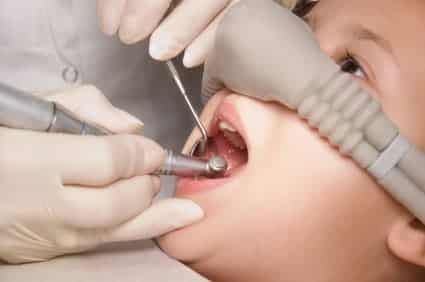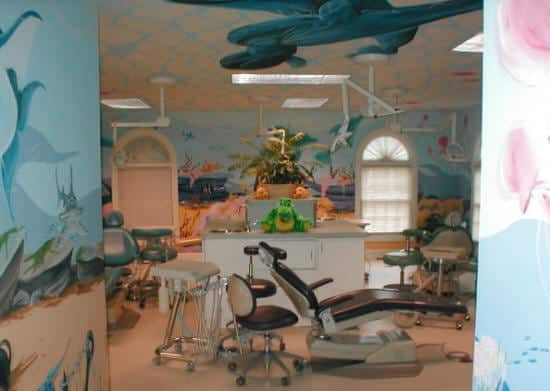What is a Pediatric Dentist?
Baby teeth are just as susceptible to tooth decay, if not more so. It is important for parents to help toddlers and young children care for their tiny chompers during the first few years, to ensure proper growth, cleanliness and good habits. But did you know your little one would also benefit from visiting a dentist when they turn one? It’s true. The ADA (American Dental Association) recommends parents start taking their children to see the dentist when they turn one. It’s at that time a parent should start considering if the family dentist will do, of if they should take their child to see a pediatric dentist.
Pediatric dentists are the pediatricians of dentistry. A pediatric dentist has two to three years specialty training following dental school and limits his/her practice to treating children only. Pediatric dentists are primary and specialty oral care providers for infants and children through adolescence, including those with special health needs. Now, obviously most family or general dentists can see child patients. But there are times when taking your child to see a pediatric dentist is the better option. Communicate your child’s needs with your own dentist. Take them in for a visit and see how they react. Once you know how your dentist is with your child, and how your child is with your dentist, you can decide if a pediatric dentist is right for you and your child.

Founded in 1947, the American Academy of Pediatric Dentistry is a not-for-profit membership association representing the specialty of pediatric dentistry. The AAPD’s 7,800 members are primarily oral health care providers who offer comprehensive specialty treatment for millions of infants, children, adolescents and individuals with special health care needs. The AAPD also represents general dentists who treat a significant number of children in their practices. As advocates for children’s oral health, the AAPD develops and promotes evidence-based policies and guidelines, fosters research, contributes to scholarly work concerning pediatric oral health, and educates health care providers policymakers, and the public on ways to improve children’s oral health.
How do you prepare your child, and yourself for a visit to the pediatric dentist?

Before the visit, ask the dentist what procedures will be performed so there are no surprises. Plan a course of action to manage your child’s reaction to the visit. This works best if you know your child’s reactions to new things. Keep in mind a dental office can have numerous loud, unusual sounds, bizarre smells and scary looking equipment. Before going to see the dentist, talk with your child about what he may see or hear at the office. Some children may be non-cooperative, if you know your child doesn’t have the patience to sit still for more than 30 minutes, acknowledge that fact with the dentist. Talk to your child about what to expect and build excitement as well as understanding about the upcoming visit. Most places now allow you to register and fill out forms online before coming in (just like Affiliated Dentists Madison), but if your child has a significant health history or health concerns, be sure to bring medical records for the dentist to look over, just in case. When scheduling for the first few visits to the dentist, be sure you are only scheduling for the one child. This ensures your attention is solely with your child and not divided between children– forcing you to go from one operatory to another, which can cause small panics when your children don’t see you sitting with them. If you know your child will be afraid of the equipment at first sight, schedule yourself with a dentist, and bring your child along to watch. This can ease some fears and allow your child to see what the equipment is used for before having them used on him.
Why is it important to fix baby teeth that have decay?
“Look Ma, no cavities” is what every parent wants to hear at the end of a dental appointment, and preventive dentistry is keeping more children free of decay than ever before. But when a child faces a dental problem, treatment is the right and responsibility of a parent. You have the right to be fully informed about the treatment choices for your child’s condition. You have the responsibility to work with the pediatric dentist to make the best treatment decision for your child. Half of all American children under the age of 12 have never had a cavity. That means half of them do. If the child has tooth decay, new treatments are available that are far more attractive and comfortable than in the past. As the parent it is your responsibility to know your options and discuss them with your pediatric dentist.
It is very important to maintain baby teeth because these teeth hold space for the future eruption of permanent teeth. If a baby tooth decays or is removed too early, the space necessary for the permanent tooth is lost and can only be regained through orthodontic treatment. Infected baby teeth also can cause permanent teeth to develop improperly, resulting in permanent enamel defects and weaker teeth. Parents may not realize that a baby’s tooth can decay soon after it first appears. The decay may even enter the underlying bone structure, which can hurt development of the permanent teeth and jaw. This problem is frequently referred to as baby bottle tooth decay. This decay is caused by long-term exposure of a child’s teeth to liquids containing sugars. When a child consumes a sugary liquid, acid attacks the teeth and gums and causes decay.
How are baby teeth restored?
Depending on the child’s temperament, the dentist may decide to treat the decayed teeth by using sedation or restraint on the child. Depending on the extent of the decay the pediatric dentist may choose to wait and see if your child matures enough to fill the cavity in the more traditional office setting. That’s a joint decision that you and your child’s dentist should make together. It really depends on how advanced the decay is. Children 2 to 5 yrs old will typically be sedated during a filling procedure, as they may become frightened or restless otherwise and create problems for both themselves and the dentists. By sedating the child, a dentist can be sure the child remains calm and still. That is why seeing a pediatric dentist is beneficial for small children. Most family practice dentists do not use sedation, and are not otherwise equipped to accommodate the needs of very young children.

Tooth Decay Treatment Options:
To treat a cavity, the first step is to remove the decayed part of the tooth. Pediatric dentistry now offers three choices for decay removal: the traditional dental drill, microabrasion and laser treatment.
- The dental drill, called a handpiece, remains the technique of choice for removing tooth decay. High-speed handpieces make treatment quicker and more comfortable than in the past, although children still may feel vibrations during the process.
- In microabrasion, which is different than cosmetic forms of microabrasion, a high-pressure instrument cuts away decay by blowing a stream of tiny particles at the tooth. Microabrasion is comfortable for children and free of the vibrations of the drill, although it cannot be used for all types of cavities.
- A dental laser light can cut through the decayed part of the tooth to remove it. It is usually comfortable and is free of the vibrations felt with the drill. Laser treatment may take longer than the other two approaches and cannot be used on teeth that already have fillings. Because this approach is relatively newer than more traditional approaches, many pediatric dentists are taking a “wait and see” attitude on the practicality and effectiveness of lasers.
Once the decay is removed, the next step is filling the hole where the decay was. Talk to a pediatric dentist about which of the many choices of filling materials is best for the child.
Preventive Resins:
If a child has a tiny cavity on the chewing surface of a baby tooth or permanent tooth, then she may be a good candidate for preventive resin treatment. After the decay is removed, the tooth is filled with a tooth-colored plastic and then coated with a sealant. The filling is virtually invisible, and the tooth is free of decay and protected by the sealant.
Tooth-colored fillings:
Tooth-colored fillings are made from durable plastics called composite resins. Similar in color and texture to natural teeth, the fillings are less noticeable and more attractive than other types of fillings. Your child can smile, talk and eat with confidence. Certain tooth-colored filling materials (such as glass ionomers) even release fluoride, resulting in a tooth that is more resistant to decay. In addition, tooth-colored fillings are compatible with dental sealants. A tooth can be filled and sealed at the same time to provide extra decay protection.
Resin fillings are not for every cavity. They work best in small areas of decay in low-stress areas. A pediatric dentist may not recommend a tooth-colored filling for a large cavity in a back tooth. Resin fillings may cost more than amalgam (silver) fillings because they take longer to place. Plastic fillings are not as durable as metal fillings.
Amalgam Fillings:
Amalgams, the silver-colored fillings you probably got as a child, are still serving children well today. Amalgam fillings are made of a mixture of metals including silver, copper, tin, and mercury. Their relative low cost, ease of placement, and durability contribute to their continued use. However, amalgam fillings require removal of healthy tooth structure in order to achieve adequate retention. Because they lack the aesthetic appeal of composite resins, their use is limited to back teeth with small to moderate sized cavities. Used for over 100 years, amalgam fillings have been proven safe with patients all over the world. In a few rare cases, some patients are allergic to the metals used in amalgam fillings. If a child has an allergy to metals, a filling material other than amalgam may be chosen. Amalgam fillings should not be used in primary molars where decay is extensive or for patients who are at high risk for decay and have multiple and/or large cavities.
The filling type is a decision you, as the parent, must make. Ask the pediatric dentist as many questions as you need to in order to make a firm and informed decision.

A pediatric dentist made the decision early in their education to specialize in working with children. They are patient, compassionate and generally enjoy working with children. Pediatric dentists try to make their office and workspace feel inviting and welcoming, and maybe even a little entertaining for children, so they can feel at ease in unfamiliar surroundings. Pediatric dentists and their co-workers often find chatting and getting to know a child before starting any procedures or treatments also help to keep children calm, and can create a special bond of trust between the two. That trust can result in a very healthy relationship that will help your child keep his very healthy smile.


